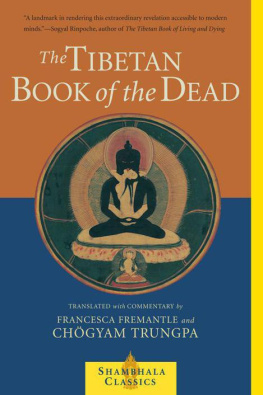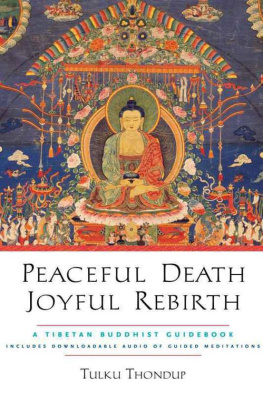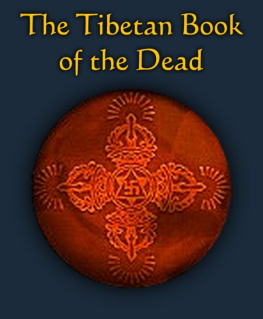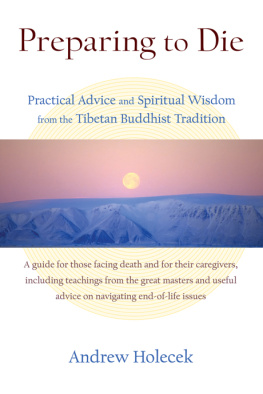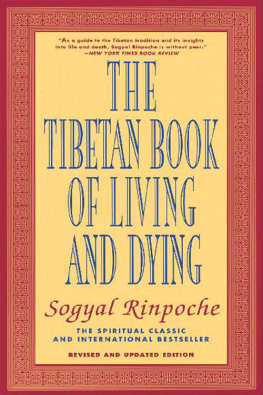The Tibetan Book of the Dead

THE GREAT LIBERATION THROUGH HEARING IN THE BARDO
BY G URU R INPOCHE
ACCORDING TO K ARMA L INGPA
Translated with commentary by
Francesca Fremantle &
Chgyam Trungpa

SHAMBHALA
Boston & London
2010
S HAMBHALA P UBLICATIONS , I NC .
Horticultural Hall
300 Massachusetts Avenue
Boston, Massachusetts 02115
www.shambhala.com
1975 by Francesca Fremantle and Diana Mukpo
All rights reserved. No part of this book may be reproduced in any form or by any means, electronic or mechanical, including photocopying, recording, or by any information storage and retrieval system, without permission in writing from the publisher.
The Library of Congress catalogues the original edition of this work as follows:
Karma-glin-pa, 14th cent.
The Tibetan book of the dead: the great liberation through hearing in the Bardo/by Guru Rinpoche according to Karma Lingpa: a new translation with commentary by Francesca Fremantle and Chgyam Trungpa.Berkeley: Shambhala, 1975.
XX,119p.: ill.; 24 cm.(The Clear light series)
Translation of the authors Bar do thos grol.
Bibliography: p. 111112. / Includes index.
eISBN 978-0-8348-2147-7
ISBN 978-0-87773-074-3 / ISBN 978-1-57062-747-7
ISBN 978-1-59030-059-6
1. Intermediate stateBuddhism. 2. Funeral rites and ceremonies, BuddhistTibet. 3. Death (Buddhism). I. Fremantle, Francesca. II. Chgyam Trungpa, Trungpa Tulku, 19391987. III. Title. BQ4490.K3713 294.3423 74-29615 MARC

DEDICATED TO
His Holiness the XVI Gyalwa Karmapa Rangjung Rigpi Dorje
CONTENTS
ILLUSTRATIONS
S AMANTABHADRA Y ANTRA
This yantra is of a sort known in Tibetan as tagdrol, which means liberated by wearing. Wearing is one of the six liberations along with hearing, seeing, remembering, touching and tasting. This yantra is placed on the body of a dead person to inspire him in the bardo of dharmat. The central figure Samantabhadra is the supreme dharmakya buddha and represents the dharmat. He is surrounded by the maalas of the peaceful deities, the vidydharas and the wrathful deities represented by their mantras. In the outermost circle are the mantras of the buddhas of the six realms. Opening page, The Great Liberation through Hearing in the Bardo: Commentary.
P ERNAGCHEN
Pernagchen, the Black-Gowned One, is the special protector of the Karma Kagy order of Tibetan Buddhism. The Karma Kagys inherited Pernagchen from the family of Karma Pakshi, the second Gyalwa Karmapa, whose father was a tantric priest. Pernagchen, half of whose body is head and half of whose head is mouth, has repeatedly appeared in visions to holders of the Karma Kagy lineage. His crescent knife destroys the perverters of the teaching. His skull cup holds wealth, both spiritual and material, for practitioners of the teaching. Drawing by Glen Eddy. End page.
FOREWORD
T HE B ARDO T HTRL (Bar-doi-thos-grol) is one of a series of instructions on six types of liberation: liberation through hearing, liberation through wearing, liberation through seeing, liberation through remembering, liberation through tasting, and liberation through touching. They were composed by Padmasabhava and written down by his wife, Yeshe Tsogyal, along with the sdhana of the two maalas of forty-two peaceful and fifty-eight wrathful deities.
Padmasabhava buried these texts in the Gampo hills in central Tibet, where later the great teacher Gampopa established his monastery. Many other texts and sacred objects were buried in this way in different places throughout Tibet, and are known as terma, hidden treasures. Padmasabhava gave the transmission of power to discover the termas to his twenty-five chief disciples. The Bardo texts were later discovered by Karma-Lingpa, who was an incarnation of one of these disciples.
Liberation, in this case, means that whoever comes into contact with this teachingeven in the form of doubt, or with an open mindreceives a sudden glimpse of enlightenment through the power of the transmission contained in these treasures.
Karma-Lingpa belonged to the Nyingma tradition but his students were all of the Kagy tradition. He gave the first transmission of the six liberation teachings to Ddl-Dorje, the thirteenth Karmapa, who in turn gave it to Gyurme-Tenphel, the eighth Trungpa. This transmission was kept alive in the Surmang monasteries of the Trungpa lineage, and from there it spread back into the Nyingma tradition.
The student of this teaching practices the sdhana and studies the texts so as to become completely familiar with the two maalas as part of his own experience.
I received this transmission at the age of eight, and was trained in this teaching by my tutors, who also guided me in dealing with dying people. Consequently I visited dying or dead people about four times a week from that time onwards. Such continual contact with the process of death, particularly watching ones close friends and relatives, is considered extremely important for students of this tradition, so that the notion of impermanence becomes a living experience rather than a philosophical view.
This book is a further attempt to make this teaching applicable to students in the West. I hope that the sdhana may also be translated in the near future, so that this tradition may be fully carried out.
C HGYAM T RUNGPA , R INPOCHE
INTRODUCTION
B Y COINCIDENCE , this introduction was written at Rumtek Monastery in Sikkim, looking across the valley to Gangtok where, half a century ago, Kazi Dawa-Samdup translated and W. Y. Evans-Wentz edited the first English version of the Bardo Thtrl. A further link with them is provided by the fact that this new translation appeared as part of a series dedicated to Evans-Wentz.
Since their work is so widely known and has been the cause of so much interest in Buddhism, it may be asked why there is any need for a new version. Evans-Wentz himself gives part of the answer in his own Introduction, where he recognizes the pioneer character of the work. Since then, especially after the flight from Tibet of many of the highest lamas, information about Tibetan Buddhism and interest in it have greatly increased. It is no longer purely a subject of academic study, but a living tradition which is now putting down roots in the West. This makes possible a new approach to translation, in which great importance is given to the practical application of the text, and to conveying its spirit of vitality and directness.
In the summer of 1971 at the Tail of the Tiger Contemplative Community in Vermont (now called Karme-Chling), Chgyam Trungpa, Rinpoche, gave a seminar entitled The Tibetan Book of the Dead, which is included here as a commentary. During the seminar he used a Tibetan text, while the audience followed in the Evans-Wentz edition. Questions about the translation and style of expression continually came up, and as a result of these questions it was decided to prepare a new version.
In making this translation, the Tibetan edition published by E. Kalsang (Varanasi, 1969) was used, together with three blockprints. A few minor omissions and errors have been corrected by reference to the blockprints, but there are no disagreements on any essentials among these four texts. Therefore it is rather surprising to find considerable disagreement with the earlier translation. Without going into great detail, there are a few outstanding points which should be mentioned.
Next page
